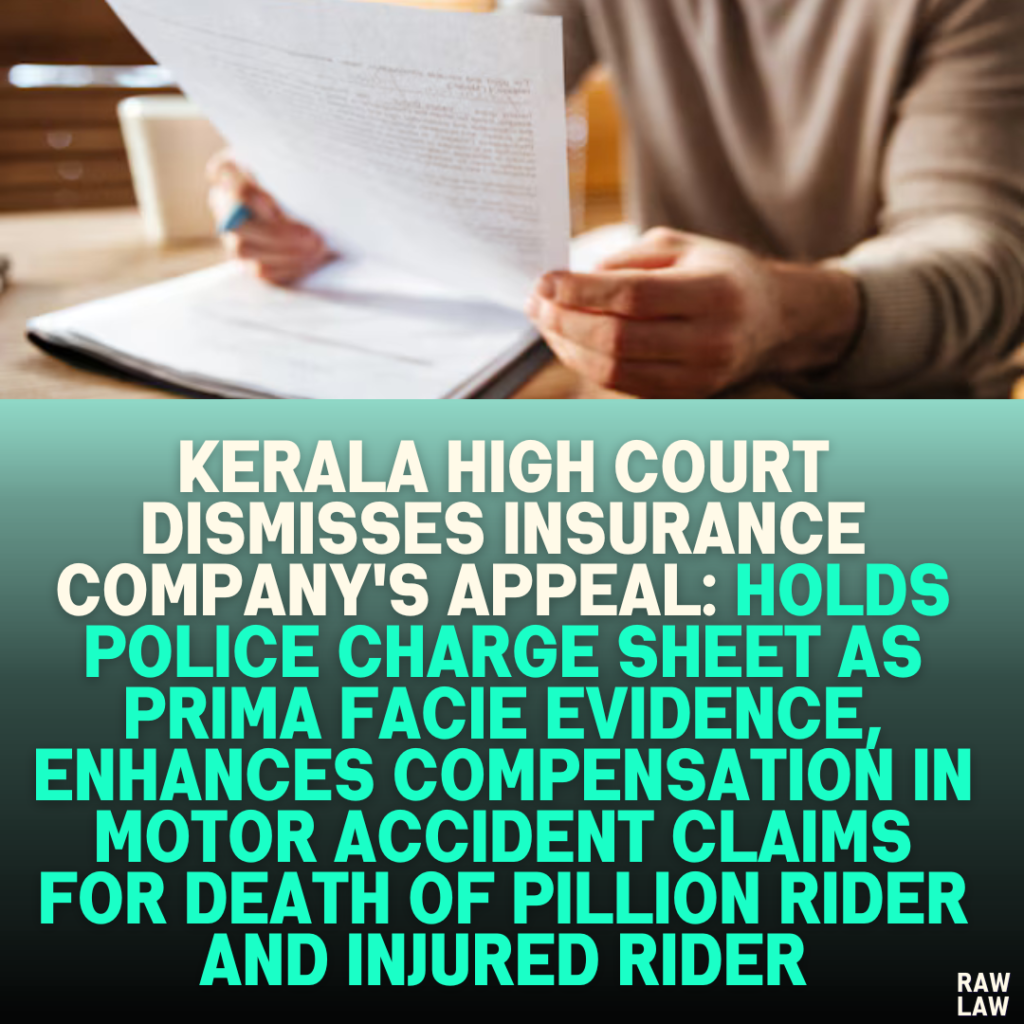Court’s Decision:
The Kerala High Court dismissed the insurance company’s appeals in two motor accident claims and upheld the Motor Accident Claims Tribunal (MACT) findings. The court:
- Affirmed that the insured vehicle (Maruti 800) was involved in the accident.
- Enhanced the compensation awarded to the claimants in both cases.
- Rejected the insurance company’s plea for introducing additional evidence at the appellate stage.
Facts:
- Accident Details:
- On 12 August 2005, a motorcycle carrying two riders was hit by a Maruti car at Kottukad junction. The collision caused severe injuries to both riders.
- The pillion rider succumbed to his injuries on 16 August 2005 during treatment.
- Tribunal Proceedings:
- O.P(MV) No.1448 of 2005 was filed by the deceased’s legal heirs.
- O.P(MV) No.211 of 2006 was filed by the injured motorcycle rider.
- The Tribunal held the insured vehicle’s driver negligent, awarding compensation of ₹5,91,150 in the first case and ₹20,575 in the second.
- Insurer’s Defense:
- Initially, the insurance company admitted the involvement of the Maruti 800 car in its written statement.
- Later, it claimed that the vehicle involved was a Maruti Esteem, citing discrepancies in the FIR and final report.
- Tribunal’s Findings:
- Based on the final investigation report, the Tribunal ruled that the insured Maruti 800 car was involved in the accident.
Issues:
- Whether the vehicle insured by the appellant (Maruti 800) was involved in the accident.
- Whether the compensation awarded by the Tribunal was appropriate and required enhancement.
Petitioners’ Arguments:
- Relied on the final investigation report (Ext. A6) to prove the involvement of the insured Maruti 800 car.
- Argued that the compensation awarded was inadequate, especially under the heads of dependency loss and consortium.
Respondent’s Arguments:
- Claimed the vehicle involved was initially reported as a Maruti Esteem, not the insured Maruti 800.
- Asserted that the final report substituting the vehicle was flawed and sought permission to introduce additional evidence to substantiate its claim.
Analysis of the Law:
- Evidentiary Value of Police Reports:
- Citing New India Assurance Co. Ltd. v. Pazhaniammal, the court held that police charge sheets are prima facie evidence of negligence in motor accident claims. If contested, the onus lies on the disputing party to provide contrary evidence.
- Rejection of Additional Evidence:
- The insurance company sought to introduce additional evidence (criminal court judgment and depositions) under Order 41 Rule 27 CPC.
- The court rejected this plea, stating that the insurer failed to show due diligence in procuring and presenting this evidence during the original trial.
- Standard of Proof in Motor Accident Claims:
- Relying on Mathew Alexander v. Muhammed Shafi, the court emphasized that claimants need only prove negligence on a balance of probabilities, not beyond a reasonable doubt.
- Compensation Assessment:
- The court applied principles from Pranay Sethi, Sarla Varma, and other precedents to reassess compensation, particularly regarding future prospects, dependency loss, and notional income.
Precedent Analysis:
- Future Prospects:
- Following Pranay Sethi, the court added 40% to the deceased’s income for future prospects.
- For the injured claimant, it relied on Ramachandrappa and Syed Sadiq to determine the notional income at ₹5,000/month for 2005.
- Multiplier and Deduction:
- In line with Sarla Varma, the court applied a multiplier of 18 (age group 21–25) and deducted 50% for personal expenses (unmarried deceased).
- Conventional Heads:
- Enhanced compensation for loss of estate, consortium, and funeral expenses based on Pranay Sethi.
Court’s Reasoning:
- The court found no credible evidence to contradict the investigation report identifying the insured vehicle as the one involved in the accident.
- The insurance company’s failure to present contrary evidence or meet procedural requirements for additional evidence under Order 41 Rule 27 CPC undermined its case.
- The compensation awarded by the Tribunal was reassessed and enhanced to align with evolving judicial standards.
Conclusion:
- Appeals by the insurance company were dismissed.
- Compensation in O.P(MV) No.1448 of 2005 was enhanced from ₹5,91,150 to ₹9,42,250, with 9% interest.
- Compensation in O.P(MV) No.211 of 2006 was increased by ₹11,166, bringing the total to ₹31,741.
Implications:
- Reinforces the evidentiary value of police charge sheets in motor accident claims.
- Sets a high standard for introducing additional evidence at the appellate stage.
- Demonstrates a progressive approach in assessing compensation, ensuring fairness to victims.
The judgment underscores the responsibility of insurance companies to produce robust evidence if challenging police investigations or claimants’ assertions. It also highlights the judiciary’s commitment to fair and adequate compensation for victims.




Pingback: Delhi High Court Stays Disqualification of Plaintiff in USI Elections, Rules WhatsApp Is Not Social Media and Violating Election Code Without Prior Notice Breaches Natural Justice: "The plaintiff has established a prima facie case" - Raw Law